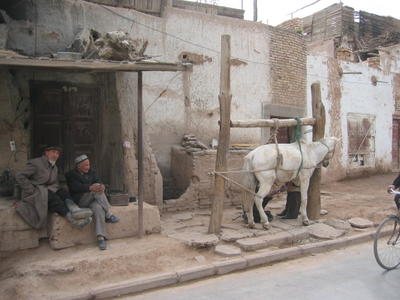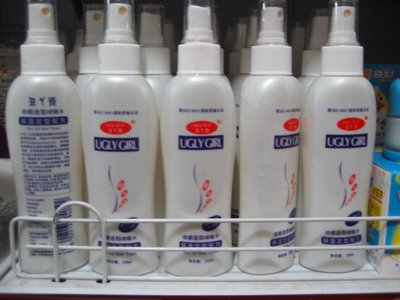 Greasy, spicy kettle style chips? - fantastic!
Greasy, spicy kettle style chips? - fantastic!
Xinjiang, bordering eight other countries, had a unique mix of people and was distinctly different to the rest of China. It's like you have stepped into another country ... and another century. It is worlds away geographically and culturally from the China most of us know... for example,
- there is a whole new language to be learnt, with the gutteral sounds of the Turkic orginated Uighur language resonating around you,
- a whole new cuisine to dapple in - kebabs, pilaf, 'chuchura' (mutton dumplings, again!), 'girde nan' (bagels), 'nokot' (chickpeas with carrot), walnut slice for dessert and the ubiquitous 'opke' a broth of bobbing goats' heads and stuffed intestines which we avoided like the plague,
- and new people to mix with, a fascinating mix of Uighurs, Tajiks, Krygyz, Uzbeks and of course the Han Chinese.

Do you have a DVD player in your sun visor?
Our immediate reaction was 'stuff the sexy and fashionable "Free Tibet campaign" with Richard Gere and the Beastie Boys - what about these guys?? In China's efforts to maintain control of this region (for it's oil and it's strategic location) Uighur separatists are executed and their whole Roman alphabet phased out as it was considered that it gave them an advantage in learning English. Can we have a celebrity campaigner to support these guys please??

Public transport Kashgar style
 How's this for my James Dean look? (we promise he was smiling prior to and after the photo :)
How's this for my James Dean look? (we promise he was smiling prior to and after the photo :)
Perhaps the first thing to get used to after arriving in Xinjiang was 'Xianjiang time'. The province is several time zones removed from Beijing but China refuse to acknowledge this. There is an unofficial Xinjiang time of two hours delay and we had to clarify which time they were going by everytime we booked anything.
After passing a surprisingly painless 23 hours on the train, across some surprisingly diverse desert scenery (including extensive wind farms), we arrived in Kashgar. Our accommodation in the grounds of the old British Consulate was a throwback with the 1950's architecture, it was totally trapped in a timewarp. Our room was really drab and I don't think the decor had been updated since the Consular days. You could imagine the hoi polloi expats drinking their G&T's in the courtyard on a hot summer's evening. It was a stretch of the imagination though, with temps dropping below zero by the time the sun had gone down.
On several occassions walking down the street, we had to stop and remind ourselves that this was still China. In the old quarter we were taken aback with what seemed like old medieval times with mud brick walled houses, donkey carts in the street, and vendors pedalling shimmering silks, gleaming knives and elaborate jewellery. Blacksmiths and cobblers operated out of tiny little workshops and stalls that spilled out onto the streets and the whole place seemed alive at any given time of day. You could smell the wafting aromas of the bakers and their fresh sesame and onion nans (like Indian naans), the strong scent of the spice and herb dealers, and there was the constant clanging sounds of the metal workers, it was sensory overload.

The Uighur old town in Kashgar
The 'fashion de riguere' of Kashgar for women was to paint in a monobrow if you weren't lucky enough to be born with one - sorry guys, no pics of this one.
The highlight of Kashgar was defintely the Sunday Livestock Market. We got there early (obviously a little too early as we hadn't gotten used to the use of Xinjiang time) and saw the market slowly grow from a an empty dusty paddock to a wild, mind boggling chaos of a market brimming with people, trucks, horses, cows, sheep, goats and donkeys. We got right into it, watching people 'test drive' horses, sheep getting dolled up (sheared) for a big sale, and in the end didn't even flinch as overloaded trucks full of muddy cows squirted poo on us as they passed by.

Translation please?

The Kashgar Sunday Livestock Market

Driving a hard bargain
The actual Sunday Market itself, well known for it's silk carpets, jewellery and hats was a little let down in comparison. Perhaps the only thing of interest was the numerous stalls selling fake Viagra (and the associated crowds of men straining to make a purchase).

Some unwilling sale items

Nice hat!
As we were experiencing all of this, Hobbes was a little worse for wear, dosed up on Immodium and being thousands of kilomteres away from qualified medical attention, he self diagnosed and prescribed himself a course of antibiotics from the extensive medical kit we are carrying - a process he is quite familiar with now, after the monthly bouts of gastro in Vietnam. This limited us to hanging around town rather than venturing into the desert or visiting the nearby Karakul Lake.
The train journey crossing back east across the desert was similarly spectacular to the first, particularly when we woke at sunrise at the point where the plains met the mountain ranges and everything was covered with a light dusting of snow. This was an awe inspiring experience in the glow of the rich warm morning light after a weary night sharing a cabin with a drunk that was coughing up a lung with what we suspected as TB. We were keen to offer him a little advice to cut back on the quarter hourly fag breaks, but decided our Chinese was not yet up to the challenge and that smiling while the phlegm was flying was much easier. Aimes for some reason felt a bit of a sense of responsibility for him as she was running off to get hot water for him in the morning, to ensure he got his sustenance from his breakfast of two minute pot noodles (a Chinese traveller's staple).

A 'lively' corner in Kashgar's Uighur Old Town

Yet more 'frenetic' action in the Old Town
After another 23 hours on a train we arrived at another ancient Silk Road town - Turpan (or Tulufan if you're Chinese). Turpan is a prime example of the Chinese not missing when it comes to charging for seeing sights. The town itself is not much to write home about (despite beautifying efforts such as building grape trellisses over the roads) but there are many sights (primarily deserted old towns) in the surrounding desert. Just about everyone in town with a car tries to sign you up for a trip to see them for 200 to 300 yuan, which is quite reasonable until you calculate that the entry fees are another 200 ++ yuan per person. Fortunately a lot of the places are apparently pretty crappy, which allowed us to restrict our trip to a couple of the better ones.

Snow covered desert
As for Kashgar, it was well and truely low season in Turpan, with many tourist businesses closed and only 2 other travellers sighted in 3 days. This is despite the fact that it would seem the most pleasent time to visit, being around 22 degrees compared with 45+ in summer and sub-zero in winter? This extreme climate results from the fact that Turpan is located within the second lowest depression on the planet (after the Dead Sea) at 153m below sea level. Not being divers this makes it the deepest we have yet been (and this statement probably proves we aren't divers :)

Near the village of Tuyoq
We visited the small Uighur village of Tuyoq which lies in a valley of the Flaming Mountains (of Monkey Magic Fame) and is one of the most important places of pilgrimage for central asian muslims (apparently seven visits is worth the same as a vist to Mecca?). The town was quite amazing, feeling as though we had stepped back even further in time than in Kashgar, and perhaps transported to the Middle East. Climbing a hill near the town allowed you to see the stark contrast of the green grape vines of the village with the barren desert only metres away - a testament to the hydraulic engineering skills of the people (just had to slip that one in). Further up the valley from the town are a group of small buddhist grottoes high in the cliffs which were constructed at the height of the Silk Road.

Heavy traffic on the way to the Buddhist grottoes

Aimes surveys the hydraulic engineering achievments of the Uighurs
On our high-speed return leg (what car trip in China isn't high speed) we stopped off at another point along the Flaming Mountains, however the clouds conspired against us and there wasn't any flaming action to be seen. Still the gnarled cliffs make for a pretty imposing backdrop to the dead flat basin that otherwise surrounds Turpan.

It's a Muslim world in Xinjiang
The other noteworthy sight in Turpan was the Emin Minaret, which is one of the most beautiful buildings we have seen. It is reached after walking for an hour or so though narrow streets jointly plyed by donkey carts and speeding Chinese mini-bus drivers, and lined with Uighur people cleaning meat, selling bread and playing cards. It comes as some surprise when you come upon the Minaret at the end of a tiny dusty lane, although perhaps this adds to the appeal?

The Emin Minaret

and again...
In addition to trying to avoid Chinese tourist traps, we also managed to enjoy waaaaay too many dumplings (we think the lady in the shop thought we had moved in) and made the most of what might have been our last chance to enjoy Uighur bread.

We wonder why this product was relegated to the 1 Yuan shop?
From here we decided to avoid a return trip to Urumqi and take a train directly to Dunhuang, just inside Gansu province.
No comments:
Post a Comment